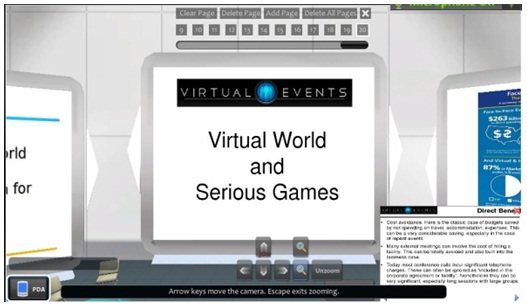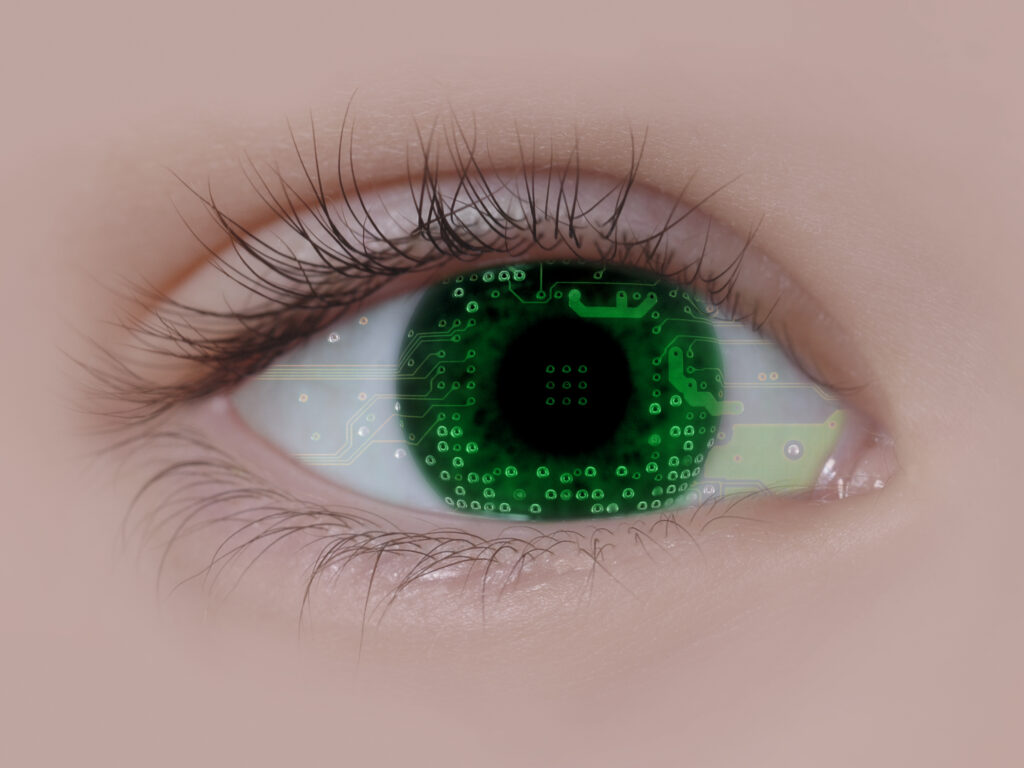Stephen Walker continues with his look at learning delivery and the various technologies in use now and in the future.
Virtual worlds
Virtual worlds provide an interesting – and now commercially viable – method of remotely delivering learning. The virtual world will be novel to some but Generation Yers will be at home through exposure to advanced virtual world games.

The user interface can be clunky to those unfamiliar with the technology. The use of voice over internet allows you to talk to everyone in the room. But it has the same issues of lack of visual cues that teleconferences do. Perhaps your in-world figure could raise its hand when you want to speak? I’m sure the virtual world designers can invent a visual cue.
In a virtual world you have a virtual face-to-face meeting and perhaps some of the camaraderie you get in physical meetings. The usual presentation facilities exist: whiteboards, PowerPoint, breakout sessions and of course more tools being added all the time. You could even use webcams to check for eyelids and send a private message to the person snoring!
You should be aware of this rapidly evolving technology. It represents the peak of commercially viable online learning today. All from your desktop PC too.
 "Many skills can be delivered online or as needed while others need face-to-face and experiential learning. The future economics of learning will drive how the learning is delivered. If something can be taught virtually, it will be."
"Many skills can be delivered online or as needed while others need face-to-face and experiential learning. The future economics of learning will drive how the learning is delivered. If something can be taught virtually, it will be."You can see one solution for yourself at http://hostavirtualevent.com/vworld/player. It is ingenious.
Video teleconferencing
By this I mean a video-enabled meeting room that projects you as if you were in the room – a series of screens sat around a table. This technology has been around for some years but the need for special conference rooms and the expensive high speed data links has left this solution as the preserve of the wealthy for the time being.
3D projections – the hologram
It isn’t too difficult to imagine video teleconferencing based around holographic images. It would answer a number of problems arising from the hidden body language. You could see who was asleep, who was slouched in the chair and who was alert. Star Trek Voyager invented the Emergency Hologram Doctor so I can’t claim credit. 3D projectors are being designed and mobile phone companies are introducing phones with 2D projection already.
It is happening now, all that is needed is to improve performance and drive down costs for commercial viability.
The dim future
I present three candidates for Learning Tool of the Year 2035.
- Online learning with supervisory software to check for your puzzlement, understanding, boredom or doziness
- The { Enter topic } Skill Navigator – for example if you want to praise someone you call up an app and it takes you through how to stand, what to say and what to do and so on
- The Holodeck – as portrayed in Star Trek again. A computerised representation of a room with the learner seamlessly integrated: a visually real virtual world allowing complete interactability
Conclusion
The pressures on time, cost and the environmental impact will increase every year. It makes sense to reduce the time and cost lost to travel as much as is possible. I have stressed ‘commercially viable’ several times in this article. One trend seems unlikely to reverse – travel will get increasingly expensive and data communications will get cheaper.
Many skills can be delivered online or as needed while others need face-to-face and experiential learning. The future economics of learning will drive how the learning is delivered. If something can be taught virtually, it will be.
The world needs learning and new skills to survive and prosper. The economics of delivering that learning will change at the speed of technology’s process improvement. Something akin to Moore’s Law (computer power will double every two years) will appear in the L&D field. More and more subjects will be delivered remotely online with the learner proceeding at their own time and pace.
Will we see a hollowing out of L&D providers (as has happened in UK grocery retail) into mass low cost providers and high value bespoke gurus? Or is the message of the economic recession of the Noughties that it has already happened?
Stephen is a co-founder of Motivation Matters, set up in 2004 to develop the management of motivation to inspire greater performance. A published author of articles and Conference speaker, Stephen delivers workshops on “doing more with less” across the country. It is all about making people WANT to work, he says. You can follow Stephen on LinkedIn, Twitter, Facebook, YouTube and blog
Stephen Walker continues with his look at learning delivery and the various technologies in use now and in the future.
Virtual worlds
Virtual worlds provide an interesting - and now commercially viable - method of remotely delivering learning. The virtual world will be novel to some but Generation Yers will be at home through exposure to advanced virtual world games.

The user interface can be clunky to those unfamiliar with the technology. The use of voice over internet allows you to talk to everyone in the room. But it has the same issues of lack of visual cues that teleconferences do. Perhaps your in-world figure could raise its hand when you want to speak? I'm sure the virtual world designers can invent a visual cue.
In a virtual world you have a virtual face-to-face meeting and perhaps some of the camaraderie you get in physical meetings. The usual presentation facilities exist: whiteboards, PowerPoint, breakout sessions and of course more tools being added all the time. You could even use webcams to check for eyelids and send a private message to the person snoring!
You should be aware of this rapidly evolving technology. It represents the peak of commercially viable online learning today. All from your desktop PC too.
 "Many skills can be delivered online or as needed while others need face-to-face and experiential learning. The future economics of learning will drive how the learning is delivered. If something can be taught virtually, it will be."
"Many skills can be delivered online or as needed while others need face-to-face and experiential learning. The future economics of learning will drive how the learning is delivered. If something can be taught virtually, it will be."You can see one solution for yourself at http://hostavirtualevent.com/vworld/player. It is ingenious.
Video teleconferencing
By this I mean a video-enabled meeting room that projects you as if you were in the room – a series of screens sat around a table. This technology has been around for some years but the need for special conference rooms and the expensive high speed data links has left this solution as the preserve of the wealthy for the time being.
3D projections – the hologram
It isn't too difficult to imagine video teleconferencing based around holographic images. It would answer a number of problems arising from the hidden body language. You could see who was asleep, who was slouched in the chair and who was alert. Star Trek Voyager invented the Emergency Hologram Doctor so I can't claim credit. 3D projectors are being designed and mobile phone companies are introducing phones with 2D projection already.
It is happening now, all that is needed is to improve performance and drive down costs for commercial viability.
The dim future
I present three candidates for Learning Tool of the Year 2035.
- Online learning with supervisory software to check for your puzzlement, understanding, boredom or doziness
- The { Enter topic } Skill Navigator – for example if you want to praise someone you call up an app and it takes you through how to stand, what to say and what to do and so on
- The Holodeck – as portrayed in Star Trek again. A computerised representation of a room with the learner seamlessly integrated: a visually real virtual world allowing complete interactability
Conclusion
The pressures on time, cost and the environmental impact will increase every year. It makes sense to reduce the time and cost lost to travel as much as is possible. I have stressed 'commercially viable' several times in this article. One trend seems unlikely to reverse – travel will get increasingly expensive and data communications will get cheaper.
Many skills can be delivered online or as needed while others need face-to-face and experiential learning. The future economics of learning will drive how the learning is delivered. If something can be taught virtually, it will be.
The world needs learning and new skills to survive and prosper. The economics of delivering that learning will change at the speed of technology's process improvement. Something akin to Moore's Law (computer power will double every two years) will appear in the L&D field. More and more subjects will be delivered remotely online with the learner proceeding at their own time and pace.
Will we see a hollowing out of L&D providers (as has happened in UK grocery retail) into mass low cost providers and high value bespoke gurus? Or is the message of the economic recession of the Noughties that it has already happened?
Stephen is a co-founder of Motivation Matters, set up in 2004 to develop the management of motivation to inspire greater performance. A published author of articles and Conference speaker, Stephen delivers workshops on “doing more with less” across the country. It is all about making people WANT to work, he says. You can follow Stephen on LinkedIn, Twitter, Facebook, YouTube and blog




